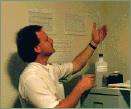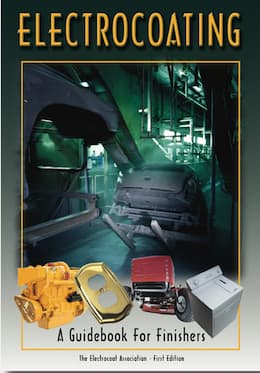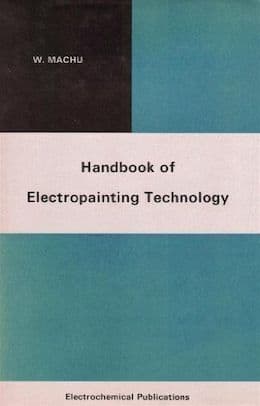
-----
CED System Issues: Recovering paint, Ultrafiltration problems
Current question and answers:
January 31, 2021Q. UF module bag filters size 25 microns have been replaced quickly; each time doesn't exceed four days and after that here occurs a high drop in the bag filters pressure.
History
We have a problem in UF membrane elements high coagulation ,
We have already replaced it by New one Parker type model EP7640BS02H7, QTY (4)
We have also transferred the ED tank to DI Rinse and cleaned the ED tank walls well and after that replaced all bag filters in our system and return again the ED materials to ED tank
After that we have high severe for bag filters for long time
We began changing the bag filters for ED and UF module around each 6 days.
What are the reasons that lead to these issues ?
- 6 october city Egypt , Giza ,
June 10, 2021
A. Good day!
Have you solved your issues in the UF membrane elements and bag filters? What were the reasons?
One of the reasons for clogging bag filters and high coagulation in UF membrane elements are particles of coagulated E-paint due to the high pH of the E-paint.
1.First of all, check microbial contamination in the demin-water, anolyte system, E-paint, and the last demin-water rinse tank before E-tank. High levels of microbial contamination can cause an increase the pH of E-paint and its coagulation. If the m/c is high, use the appropriate biocide, disinfection and acid additive.
2.Check and follow E-coating parameters of supplier: solid content, conductivity, p/b ratio, temperature, etc.
3.Also, the transfer of alkaline contaminants from the pretreatment line on the painted parts, conveyor parts might cause pollution and coagulation in the E-paint.
All the best.
- Minsk Belarus
![]() Dear Dmitriy_Belanovich,
Dear Dmitriy_Belanovich,
Very correct answer & I appreciate your exact answer.
- NASHIK
June 18, 2021
⇩ Related postings, oldest first ⇩
Phosphate in CED Bath - Membrane Fouling
Q. We have done over 12 Cathodic Electro Deposition Plant Installation. For the first time we are experiencing the problem as below -
Recently about 10 months ago, we commissioned a CED plant. UF System operation for initial five months was very smooth. After the first regeneration , of course due to drop in permeate quantity, the system had an erratic behaviour and needed regeneration every 4 to 7 days.
The paint bath is controlled regularly by the paint supplier. After studying various parameters & membrane supplier's manual, we tested the CED bath sample for phosphate contamination. The recent sample tested for Phosphate content has the phosphate level very high. As against maximum tolerance limit of 550 ppm it has reached 1068 ppm. Is their any way to remove these excessive phosphates from the CED bath? Guidance from Your expert panel shall be appreciated.This will save the 7 kl bath from likely discard. Thanks,
VISWAHNATH R. MIRASHI- PUNE, MAHARASHTRA, INDIA
2000
A. About your only hope is to fix the cause of the contamination, which is probably poor final rinsing or excessive phosphate coating as Ted alluded to. A DI rinse is almost mandatory ahead of CED baths to avoid problems like this. Once you correct the cause I'm afraid short of dumping the bath you'll just have to let the symptoms dissipate on their own. Phosphate ions in the coating won't generally cause much problem, but of course you'll have to keep an eye on performance.
As long as phosphate levels are very high, I'd try to keep regenerating the membranes as much as necessary. Then replace them when the problem is over, they'll be aged badly by all the extra regeneration. There is no way no get the phosphate ion out without affecting the paint, maybe your paint vendor can recommend a method and then deal with the results by adding only the affected components, but that's a last resort before dumping the tank.
As for the cause, look first at rinsing, then check your phosphate coating to make sure it is the correct coating weight AND is adherent to the surface. Good luck

Jeff Watson
- Pearland, Texas
2000
|
Q. Dear sir: I WANT TO KNOW ABOUT ED PHOSPHATE PROCESS. IRON AND ZINC PHOSPHATE PROCESS. SIR ALSO WANT TO KNOW ABOUT DEFECTS REMEDIES AND POSSIBLE CAUSES OF PHOSPHATING. WHAT'S EFFECTS OF pH. Shaikh Rashid Mehboob- Karachi, Pakistan 2001
Usually available on
eBay; sometimes on AbeBooks
or
Amazon
(affil links) 
free pdf is currently available from academia.edu A. Hi cousin Shaikh. You can search the site for dozens of threads about iron and zinc phosphating. If you want a more tutorial approach there are several good books on phosphating which cover these issues, including: For a quick introduction to zinc phosphating and other topics including transition metal coatings as an alternative, you can see recent issues of the Metal Finishing Guidebook. Best of luck. Regards,  Ted Mooney, P.E. Striving to live Aloha finishing.com - Pine Beach, New Jersey Ted is available for instant help or longer-term assistance. |
2007
Q. Here in our plant UF Membrane is in place which separates the Paint and the Permeate. I Know that the Paint is separated to reduce the Consumption of Paint.
But I have a simple Doubt.The Inlet for the membrane is from the Main Tank which contains Both Paint and Solvent.It is separated by the membrane through Osmosis Process but my question is the Paint is separated and is delivered to the Main Tank.The Permeate is separated and it is Passed to UF Rinse and again it is cascaded to Main tank when Level Goes Low.
So at last whatever the paint taken to the Membrane is again taken back to the Tank in Separated condition as Paint and Permeate from Rinses.
What is the Use then since the effect is zero as Paint and Permeates come Back.
Input=Output
This may be a simple question but I will happy if some one explains me clearly.
ED-Team leader - SLN_TN, India
by Electrocoat Association

on eBay or Amazon
or AbeBooks
(affil link)
A. Dear Mr Narsimhan,
By separating permeate and paint thru UF membrane and using permeate for cascade rinses, you actually form a closed loop which reduces your carry-over losses as well as solvent and additive losses.
If you discard the permeate and use fresh water for rinses, then you will loose the solvent and additives in permeate which you will have to add extra in main tank. Also, permeate removes extra paint more effectively than water since it contains these solvents and additives.
Further, cascading brings the paint back to main tank which is carried over to rinses. This saves your paint losses.
Hope the system is clear to you now.
- Pune, INDIA
A. Dear Mr. Narasimhan:
If you are actually running an E-coat system, the answer, as given by Mr. Kulkarni will be right in front of you. Allow me to give the same answer using different words.
You separate permeate from the paint and then mix them together. Paint = Permeate + Concentrated Paint = Paint
If you look at your E-coat system, the permeate goes into the Permeate rinse 2 tank, cascades into Permeate rinse 1 tank and then finally cascades into the E-coat tank.
What goes into Permeate 2 tank is clear permeate. What cascades into E-coat tank is not clear permeate. Instead it is permeate with some solid content. The function of permeate is to recover the paint which goes out of the paint bath along with the component and gets accumulated in the rinse tank.
I hope this explains the E-coat industry first separates the permeate and then allows it back into the E-coat paint.
Mohali, Punjab, India
2007
A. Dear Narasimhan,
It is a long time since I was involved with EC (1979) and now I only supply powder coating. However, the basic principles I do not think have change much. The UF Membrane if I am correct is to remove some of the solubilising agent from the tank, which consists of resin, solvent, solubilising and possibly pigment if it is coloured. The ratios of these are finally balanced and if you are to maintain the tank in good working order, these must be kept within certain limits. The solubilising agent if allowed to increase above a certain limit in comparison with the other ingredients would cause the applied wet coating to be removed (washed off) by the demin water rinse. Your lab tests for solids, MEQ's and ph etc should indicate to the person in charge of the plant what is required to keep the tank in balance -- more paint, water, less/more solubilising agent.
Birmingham, United Kingdom
2007
E COAT Paint Ultra Filtration System Fouling
Q. My name is Anil Shah, we are suppliers of Ultra Filtration Systems required for the E COAT Process in Automobile Industry. We face a typical problem with UF systems. They run well for the first year or two with excellent permeate flux stability, and also recovery of flux on system cleaning. However, subsequently permeate flux stability and recovery is a problem even with newly installed membranes.
I assume that this is possibly because the paint bath and its chemistry are good for the first year or so due to low production volumes, however, subsequently the chemistry is getting disturbed and is adverse to UF system operation.
The customer usually refers to the system supplier - however, we have limited understanding of paint chemistry. I will appreciate if some generic guidelines can be provided for testing of paint chemistry parameters which affect UF system performance.
Supplier - E Coat UF Systems - Mumbai, Maharashtra, INDIA
2007
A. The answer, my friend, is swirling in the tank!
If the quality of coating is perfect, the chemistry of the E-coat tank is in perfect health. If the customer has severe coating problems, your UF membrane could be affected. Just walk around the shop floor and see the final coating quality. You will know whether it is safe to put in the new membrane or not.
UF membranes are certainly affected by ionic contamination. But in that case the coating is already being affected and there can also be generation of sludge in the tank.
Check if regular tests are being carried out on the tank.
Mohali, Punjab, India
2007
Ed. note: How did Bob Dylan miss that line :-)
Q. My question is regarding UF Flow Rate.
1. What are the factors which decide a particular UF Flow rate?
2. What happens to the substrate if the UF flow rate is reduced?
Paint Shop - Pune
March 20, 2008
A. Hi Prasad. I'm neither an e-coat nor a UF expert, but from experience in somewhat analogous cases, it certainly seems that the higher the flow rate the lower the loss of wasted non-deposited paint from the final rinse ... but the more expensive the recovery process. I would also assume that the non-rinsed non-deposited paint could cause various problems like rubbing off, staining, etc., if it's excessive.
Regards,

Ted Mooney, P.E.
Striving to live Aloha
finishing.com - Pine Beach, New Jersey
Ted is available for instant help
or longer-term assistance.
Q. We are car assemblers in Malaysia. Recently we switch to lead free E-coat paint for our Cathodic ED system. Since then we experience high fluctuation in the ED dip tank paint level. Some times abnormally low level or very high level, which force to stop production.
Seek your kind advice to solve this problem.
Thank you in advance.
- Kuala Lumpur, Malaysia
April 10, 2008
Continuous ultra filtration in electrophoretic lacquer bath
Q. Is there any long term negative effect in using continuous ultra filtration in electrophoretic lacquer bath?
our tank has slight amount of chloride in its permeate, since due to urgent work, we did not have time to do full treatment of the lacquer, our engineer suggested using ultra filtration continuously throughout the coating process,
The quality has been much better than the original, but the engineer has also warned us against using ultra-filtration continuously in the lacquering process.
Any information on this subject would be highly appreciated.
lacquer operator - Moradabad, UP, India
February 16, 2010
May 21, 2012
Q. Dear Sir,
We are having 85KL capacity CED bath having closed loop with 3 UF rinses - 2 spray and one dip rinse. The UF system is having capacity of 1200 LPM which consumes relatively high electricity (UF system feed pump and chiller load).
For next few months from now, we have very low volume to process for CED coating (10% capacity utilisation) - in the range of 2500 sq.m only. Considering the low volume and high fixed cost for running the UF system, we want to isolate the UF module.
My question to this forum is what are the implications, if we process low volume for CED coating without running the US system? Will it have any issue other that high consumption of CED paint (due to high carry-over)? What will be the effect on bath balancing and if any how to tackle it ?
I kindly request your prompt response, please.
Warm regards,
- Baroda, Gujarat, India
Q. Good day. I am from Mexico. is it possible to use ultrafiltration for paint recovery from rinse bath located after the autophoretic paint?
Gerardo Ruiz- Mexico city, Mexico
June 2, 2017
June 2017
A. Hi Gerardo. We appended your question to a thread on a related subject which indicates that the answer is clearly "Yes!" for electrocoated paint. We'll see if people have anything to say about autophoretic.
Regards,

Ted Mooney, P.E. RET
Striving to live Aloha
finishing.com - Pine Beach, New Jersey
Ted is available for instant help
or longer-term assistance.
How to clean choked membrane?
Q. Hello.
I am doing dye gold lacquer on imitations jewellery. I'm using hollow fibre ultrafiltration to discard the permeate from the lacquer tank. The filter is not extracting the permeate efficiently. Earlier it would extract the permeate at 2 liter per minute but now it has been reduced to 500 ml per liter. So kindly suggest how to clean the choked membrane.
Thanks.
- Kolkata. India
July 20, 2018
A. Hello sunil,
you have to wash ultra filter by help of permeate first, then make a solution of solvent (which you are using in the lacquer)
-- 4 liter and emulsion stabilizer - 1 liter and 15 liter DM water.
Run the ultra filter into this solution up to 1 hour and then cool down than run for next 1 hour.
Slowly your permeate will increase.
Note: always after running ultra filter you have to clean ultra filter by permeate once a week.

Chandresh Varsani
- RAJKOT, Gujarat, India
December 15, 2018
Q. I'm currently working in e-coat plant. I would like to know the factors that affect UF flow? How to maintain consistent UF flow rate? Thank you.
Jayakumar ponniasalan- MALAYSIA selangor
November 21, 2018
A. It's been a while since I worked with E-coat, a coil coating line with e-coat primer. Apparently the only one in the world then or since. The reeds over time get plugged so you need to back flush them, just don't dead head them, an expensive mistake.
Ronald ZeemanCoil Coating - Brampton, Ontario, Canada
December 3, 2018
December 15, 2018
by Electrocoat Association

on eBay or Amazon
or AbeBooks
(affil link)
A. Hello Jayakumar ponniasalan,
the pH of the solution and the solid content will effect on the permeate rate (ultra filter flow rate), so if flow rate decreases then you have to wash the ultra filter by help of emulsion stabilizer and solvent which you are using in CED.

Chandresh Varsani
- RAJKOT, Gujarat, India
A. The solid content will affect the ultra filter flow rate, and you have to wash the ultra filter once a week at least

ahmed soliman
- 6th of October/ Giza/Egypt
December 19, 2018
Q. Hi I am jay; we have a plant supplier. I have a doubt: ratio of uf flux rate compared to tank capacity
Jay mishraCED - PUNE India
August 7, 2019
August 2019
A. Hi Jay. Hopefully a reader has a quick rule of thumb for you, but Machu spends a 7-page subchapter on sizing and deploying UF units for various situations. Good luck.
Regards,

Ted Mooney, P.E. RET
Striving to live Aloha
finishing.com - Pine Beach, New Jersey
Ted is available for instant help
or longer-term assistance.
Q, A, or Comment on THIS thread -or- Start a NEW Thread
